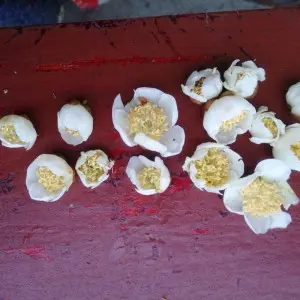Mar . 04, 2024 12:15 Back to list
Pollen Allergy Frequently Asked Questions
-
Q 1: What is pollen?
Pollen is a fine powder produced by the male flowers of seed plants when they reproduce (pollination). It travels from one flower to another with birds, insects, and the wind.
Some flowering plants, including wattle trees, produce small amounts of pollen which are spread by birds and insects.
Other plants such as pasture grasses and weeds rely on wind to spread their pollen. These pollens are produced in large amounts and can travel long distances.
Q 2: What pollens cause allergies?
Most of the pollens that cause allergies are produced by airborne pollen from northern hemisphere grasses, trees and weeds:
- Pasture grasses are more allergenic than Australian native grasses.
- Pollen from exotic trees is more allergenic than pollen from Australian trees.
Several types of weeds with highly allergenic pollen have been introduced to Australia and New Zealand, including:
- Pellitory weed, also known as asthma weed, was accidentally introduced in a shipload of marble from Italy in the early 1900s. It is mainly found in Sydney.
- Paterson's Curse (Echium plantagineum) is a flowering plant that was deliberately brought from England in the late 1800s by Dr Paterson. It has taken over large areas of grass in rural Australia and produces highly allergenic pollen.
- Ragweed and Parthenium weed were introduced in pasture seed imported from the United States. They have spread throughout Queensland and northern New South Wales.
Q 3: What are the symptoms of pollen allergy?
Symptoms are caused by the body's immune system response to inhaled pollen, resulting in chronic inflammation of the eyes and nasal passages. Many people who have these symptoms refer to it as hay fever, but the correct term is allergic rhinitis.
Allergic rhinitis symptoms include:
- Runny, itchy, congested nose.
- Irritable, itchy, watery and red eyes.
- Itchy ears, throat and mouth.
Allergic rhinitis can increase the risk of people developing sinusitis.
Q 4: Can pollen trigger asthma?
For some people, pollen can directly trigger asthma as well as allergic rhinitis. When pollen granules come into contact with water, starch granules are released that are small enough to be breathed deep into the airways. This causes allergic rhinitis and what is known as thunderstorm asthma in some people.
People who wheeze during spring and/or summer should see their doctor for advice.
Q 5: Is there a pollen season in Australia?
In Australia, the amount of pollen particles in the air (also known as pollen count) is lower on the east coast where most winds come from the sea, and where there is protection from westerly winds by the Great Dividing Range. The pollen count is usually higher on the Victorian south coast because most winds are from the north, carrying pollen from the northerly grasslands. In South Australia and Western Australia, the pollen count can vary according to the wind.
Pollination times vary with the plant variety and its location. Trees usually pollinate in late winter and early spring.
- White Cypress (Murray) Pine is the only Australian tree that produces highly allergenic pollen. It grows from the western slopes and plains of eastern Australia across to Western Australia, south of the Tropic of Capricorn, and flowers from late July through to the end of August.
- Wattle trees are frequently blamed for early spring allergy symptoms, but tests rarely confirm that Wattle pollen is the cause.
- There are many species of Casuarina or Australian Oak trees, which produce pollen throughout the year and may cause allergic rhinitis symptoms at any time of the year.
Grasses flower next, and the weed 'Plantain' flowers from August through to May.
The main grasses growing in the northern coastal areas are subtropical and mostly flower in January, February, and March. Allergenic grasses in the southern part of Australia are mostly Northern hemisphere grasses, with the main flowering period from October to December.
Q 6: How is pollen allergy diagnosed?
A history should be taken of the timing of symptoms, identifying plants and trees that grow in the area. It is also helpful to know if symptoms improve when away on holiday.
Once the person’s allergy history has been recorded, skin prick tests using allergens found around their home and work should be done. Blood allergen specific immunoglobulin E (IgE) tests may also be required. Test results should be interpreted by a doctor trained in allergy who will consider the person’s medical history.
-
Kiwifruit Male Pollen For Kiwifruit Pollination

-
Q 7: How can exposure to pollen be reduced?
- Stay indoors on windy days when pollen counts are high.
- Avoid going out just before, during, or after thunderstorms.
- When outside, wear sunglasses and carry tissues or handkerchiefs.
- Shower and rinse eyes with water after being outside.
- Stay inside when grass is being mown. If mowing grass, wear a mask.
- Keep windows closed at home and in the car and use recirculating air conditioning in the car.
- If landscaping at home, research which plants are less likely to trigger allergic rhinitis or asthma and plant these in the garden. Remove plants to which you are sensitive.
-
Pollen Peach Tree for Pure Pollination and High-Quality Peach Pollen
NewsJul.30,2025
-
Premium Cherry Pollen for Pure Pollination & Different Types
NewsJul.30,2025
-
Artificial Pollination Solutions for Various Plant Pollen Types
NewsJul.29,2025
-
Artificial Pollination Solutions for All Plant Pollen Types
NewsJul.29,2025
-
Premium Plant Pollen for Pure Pollination & Pollen Block Solutions
NewsJul.29,2025
-
Artificial Pollination Solutions for Efficient Crop Yields
NewsJul.28,2025